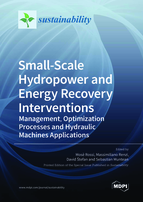Small-Scale Hydropower and Energy Recovery Interventions: Management, Optimization Processes and Hydraulic Machines Applications
A special issue of Sustainability (ISSN 2071-1050). This special issue belongs to the section "Energy Sustainability".
Deadline for manuscript submissions: closed (31 December 2021) | Viewed by 22876
Special Issue Editors
Interests: cogeneration systems; hydraulic machines; mini- and micro-hydropower; oil refinery processes; renewable energy
Interests: hydropower; pump-as-turbines; thermal management in automotive powertrains; electrification of vehicles; biofuels; hydrogen-enriched fuels use; cogeneration; internal combustion engines; micro gas turbines; optimization of energy systems; energy storage; energy transition
Special Issues, Collections and Topics in MDPI journals
Interests: design and operation of hydraulic machines; fluid mechanics; renewable energy
Interests: computational fluid dynamics; experimental investigations; hydrodynamics and cavitation in hydraulic machinery; swirling flow control
Special Issues, Collections and Topics in MDPI journals
Special Issue Information
Dear Colleagues,
The exploitation of renewable sources is fundamental for reducing greenhouse gas emissions and to cut other harmful emissions for both the Earth environment and human beings. In recent decades, several “green” technologies have been deployed; thanks to this effort, more than 26% of the global electricity production comes from renewables. Among them, hydropower is one of the most known and established worldwide, but almost all of the large-scale reservoirs have been in use for decades. However, not all the countries present morphological conditions suitable for this kind of technology; moreover, there is significant room for development in the exploitation of residual flows and smaller sources. Therefore, several studies have been conducted in recent years on small-scale hydropower plants (e.g. run-of-the river hydroelectricity), as well as on energy recovery applications in irrigation networks, water supply systems (WSSs), water distribution networks (WDNs) and industrial plants. In this regard, the present Special Issue has the aim to collect the most recent contributions and developments on the exploitation of water energy recovery potential in small-scale hydropower applications (e.g. run-of-the river hydroelectricity), irrigation networks, WSSs, WDNs and industrial plants. In particular, optimization analyses or the installation of hydraulic machines that act as pressure reducers, rather than as energy recovery systems, are the current key points for achieving environmental goals. The topics included in this Special Issue are the following:
- Current state-of-the art of small-scale hydraulic machines, with particular attention to small-scale hydropower plants (e.g. run-of-the river hydroelectricity) and energy recovery in irrigation networks, WSSs, WDNs and industrial plants;
- Future prospective of these research fields in upcoming years;
- Models and technologies that lead to an efficiency improvement of small-scale hydropower plants (e.g. run-of-the river hydroelectricity), irrigation networks, WSSs, WDNs and industrial plants (e.g. models for forecasting novel hydraulic machines performance, management and optimization processes of irrigation networks, WSSs, WDNs and industrial plants where the installation of hydraulic machines is possible);
- Development of new methods for energy performance forecasting and enhancing small-scale hydropower plants (e.g. run-of-the river hydroelectricity), irrigation networks, WSSs, WDNs and industrial plants where hydraulic machines can be installed or they are already operating;
- Case studies where the energy recovery in irrigation networks, WSSs, WDNs and industrial plants is applied by means of hydraulic machines.
The listed topics are indicative suggestions, but other emerging ones in these research fields are warmly welcomed.
In accordance with the above proposal, we would like to invite you to submit original research and/or review papers.
Dr. Mosè Rossi
Dr. Massimiliano Renzi
Dr. David Štefan
Dr. Sebastian Muntean
Guest Editors
Manuscript Submission Information
Manuscripts should be submitted online at www.mdpi.com by registering and logging in to this website. Once you are registered, click here to go to the submission form. Manuscripts can be submitted until the deadline. All submissions that pass pre-check are peer-reviewed. Accepted papers will be published continuously in the journal (as soon as accepted) and will be listed together on the special issue website. Research articles, review articles as well as short communications are invited. For planned papers, a title and short abstract (about 100 words) can be sent to the Editorial Office for announcement on this website.
Submitted manuscripts should not have been published previously, nor be under consideration for publication elsewhere (except conference proceedings papers). All manuscripts are thoroughly refereed through a single-blind peer-review process. A guide for authors and other relevant information for submission of manuscripts is available on the Instructions for Authors page. Sustainability is an international peer-reviewed open access semimonthly journal published by MDPI.
Please visit the Instructions for Authors page before submitting a manuscript. The Article Processing Charge (APC) for publication in this open access journal is 2400 CHF (Swiss Francs). Submitted papers should be well formatted and use good English. Authors may use MDPI's English editing service prior to publication or during author revisions.
Keywords
- energy efficiency
- energy recovery
- hydraulic machines
- hydropower
- irrigation networks
- industrial plants
- optimal management
- optimization processes
- renewable energy
- run-of-the-river hydroelectricity
- small-scale hydropower
- water distribution network
- water supply system









